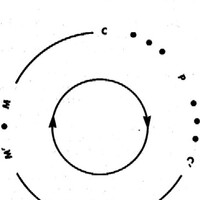-
Title
-
The Circuit of Capital
-
Description
-
Capitalist production is production for exchange -- its product consists of commodities. These commodities are commodity capital because they represent a phase in the circuit of capital, and, more specifically, because they contain the surplus-value yielded by the capitalist process of production. Marx writes the equation C' = C + c, where C represents the portion of commodity capital that is the value equivalent of the money capital (M) that began the circuit, and c represents the portion of commodity capital containing surplus-value.
To realize the value of commodity capital, the capitalist must transform it back into money form by selling it: C'--M'. Capital in the form of commodity capital, therefore, reenters the sphere of circulation. The symbol M' is used because the value realized by the capitalist upon the sale of commodity capital exceeds the money capital originally advanced. This is the case because commodity capital contains surplus-value. The sale of commodity capital, then, represents both the reconversion of original capital-value into money form, C--M, and the realization of surplus-value, c--m.
The complete form of the circuit of money capital may be represented as M--C . . . P . . . C--M', …
Note that the lines (--) symbolize acts of exchange taking place in the sphere of circulation, while the dots ( . . . ) represent the functioning of capital in the sphere of production. During the course of its circuit, industrial capital successively takes on three forms: money capital, productive capital (means of production and labor-power), and commodity capital. The transformation of money capital into productive capital, and that of commodity capital into money capital, take place in the sphere of circulation, through exchange. The conversion of productive capital into commodity capital (and the augmentation of capital-value) takes place in the sphere of production. …
The circuit of money capital ends as it began: with money. At the end of the circuit, therefore, the capitalist is in a position to purchase once more the elements of productive capital. Because the money available to the capitalist at the end of the circuit (M') contains surplus-value, the capitalist can expand the process of production, invest the additional capital elsewhere, or employ surplus-value as revenue for personal consumption. …
The continuous, or circular, nature of the circuit of capital is represented in [the Figure].
-
Designer
-
Fox, John
-
Date
-
1985
-
Source
-
Understanding Capital Volume II
-
Bibliographic Citation
-
John Fox, 1985. Understanding Capital Volume II. Progress Books. Figure 1
 ucv2-fig1.jpg
ucv2-fig1.jpg